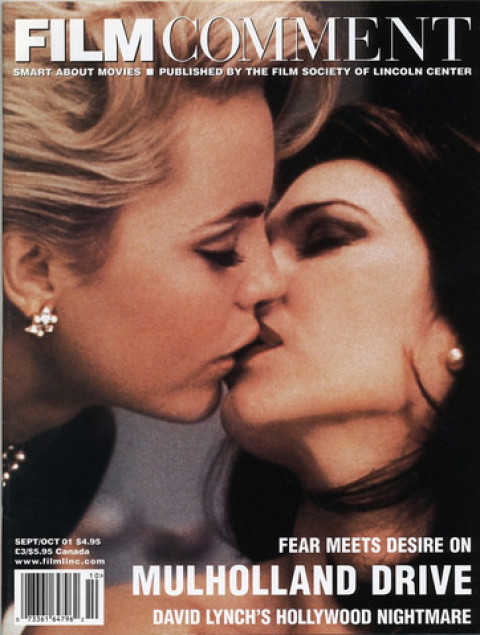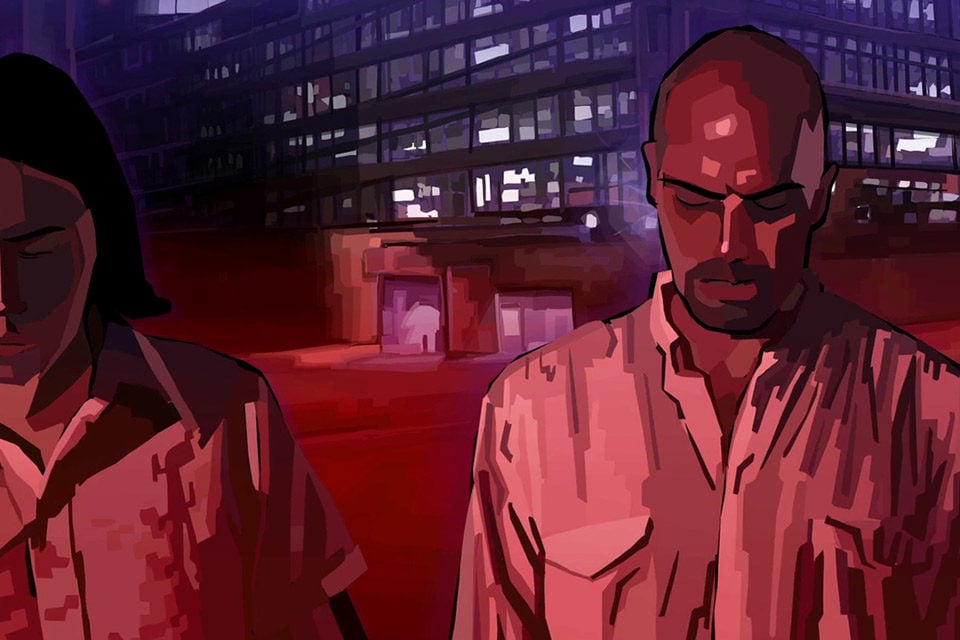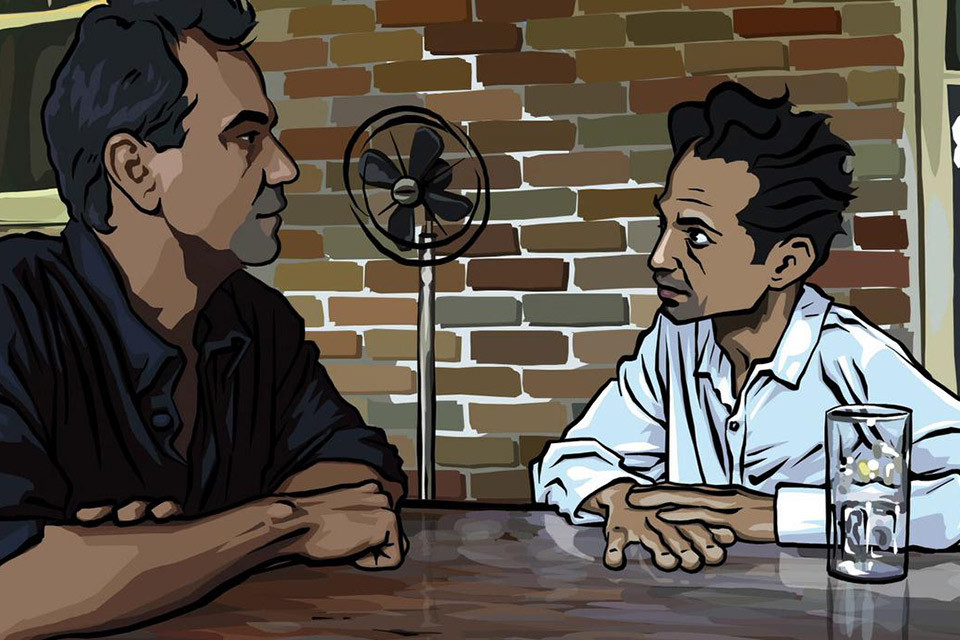
Cosmic Babble
One of the promo items for Waking Life is a coloring book. If you take a stab at it with your crayons, you’ll be neatly implicated in the film’s philosophical subtext. Richard Linklater’s new movie is animated, but the imagery and action are derived from real people. The cast was shot with digital cameras, and the subsequent footage was first edited and then processed with computer software and a device called the Wacom Tablet—the sexy beast of current animation. Video is manipulated into painterly impressionism with the stroke of an electronic pen. When applied to handheld moving images the tablet creates a whole new way of seeing. Perspective develops new dimensionality; shifting planes of space appear isolated, as if there were discrete strata between foreground and back. The results range from the almost life-like to the downright phantasmagoric. The coloring book distills the film’s imagery into black and white outlines; and anyone who fills them in brings them back to “life” with whatever colors they happen to choose. Once the crayons are put away the final look is determined by both the original presence of reality in front of a camera, and by subsequent artistic interpretation and its implicit freedom of choice. It’s a significant point; the film continuously ponders the existence of free will. The book is a brilliant example of a filmmaker turning questions of determinism and ontology into marketing strategy.

Parts of Waking Life revisit people and events from previous Linklater films. Its overall structure resembles Slacker: It’s a tour of personalities rather than a story; and its “characters” are more likely to pontificate than converse. Babble reigns; linear narrative evaporates. And even though the film may seem to be nothing more than a series of discontinuous intro philosophy lectures, a grander theme gradually emerges.
The nameless main character (Wiley Wiggins) is introduced asleep on a train—a recurrent Linklater motif. As the film proceeds, this fact gathers momentum; he soon suspects that he’s fallen into some sort of permanent dreamstate. “Dream is destiny” is Waking Life’s guiding principle; and the primacy of dreaming is introduced in the film’s opening section. A young boy, perhaps Wiley in his youth, gazes up at the night sky. A shooting star passes overhead. The event triggers a surreal reaction: The boy floats off the ground. But he’s able to grab the door handle of a parked car and thereby prevent himself from drifting off into the cosmos. This act will take on theological significance by the film’s end.

Waking Life
The way in which different sequences are handled with distinct visual treatments is extraordinary. Not only does Linklater cast colorful actors, he heightens their characteristics by providing them with their own color schemes. This is taken to fascinating extremes. In certain instances the visuals are completely unreal, yet wedded to specific thematic realities: In one scene a prisoner ruminates on his condition and talks about the violence he will unleash on the people responsible for putting him behind bars. His fleshy torso is depicted in flickering shades of blood red as he speaks of grinding cigarettes into his captor’s eyes. In a sense, he’s literally burning. This and a couple of other violent scenes are the exception in terms of the overall film, which consists of 37 vignettes, but it’s fairly startling stuff coming from a director best known for Slacker and Dazed and Confused.
Just as Waking Life looks back literally at the previous Linklater films, it gives the act of retrospection lyrical meaning. There’s a sequence featuring Before Sunrise leads Julie Delpy and Ethan Hawke together in bed. Delpy says she has a recurring vision of herself as an old woman near the end of her days. Her “waking life,” she explains, is her older self’s memories. By this point the film’s title starts to waver around what it signifies, much the same way the animation wobbles around the original source image. One way of asking what the words “waking life” mean would be to define its opposite—which isn’t that easy. Is it sleeping death? Or, perhaps, putting death to sleep? (Also: to animate means “to bring to life.”) In either event, mortality is key, and with it comes an attendant element: God.

Waking Life
One of the most mystical sequences in the film, and for me its theoretical centerpiece, is titled The Holy Moment. It’s the only scene in which a cast member is identified by name. Caveh is, in the real world, the indie actor and director Caveh Zahedi, whose work includes the appropriately titled I Was Possessed by God. (Since Waking Life’s cast consists of 55 real people—i.e., no matchup with character names—on some level the film, for all its hallucinatory stylistics, can be taken as a documentary.) Caveh sits at a table with another man and dominates the conversation with an excited exegesis on the great Catholic film theorist André Bazin. The film is very much preoccupied with its own ontology, and this is the perfect opportunity to let it all hang out. (Ontology: a subset of philosophy that deals with explanations of the nature of being. Since an ontology—there can be several—claims to describe the true nature of things, it’s helpful, especially here, to associate the practice with some sort of privileged view.) Caveh explains Bazin’s belief in the power of the camera to record reality and, by extension, God incarnate. He goes on to describe how the continuous experience of God, a sort of frame-by-frame “Holy, Holy, Holy,” is a state of affairs he would find impossible to deal with for prolonged periods because the intensity would cause him to stop talking and weep. Caveh suggests they have a Holy Moment; and we, the audience, are privy to it. What follows is a tremendous demonstration of the film’s visual style. Caveh stops speaking and locks eyes with his friend. His hair has been moving in wave-like patterns throughout his speech, but it now takes on supernatural pulsations. His pupils dilate wildly. It’s as if they have indeed become one with the moment. They begin to speak, the moment is broken, and at the end of the scene the characters morph into clouds.
Other aspects of divine intervention are more discreet. Consider this: Linklater himself appears near the film’s beginning. Wiley gets into a car that looks like a boat; the director is in the backseat next to him. A skipper-like person, prone to nautical musings, drives the vehicle. The Skipper asks Wiley where he wants to be dropped off, but Wiley doesn’t have an answer. Linklater, with a tone that is paradoxically deliberate and random, says, “Go up three more streets, make a right, go two more blocks and drop this guy off on the corner.” “Where’s that?” asks Wiley. The Skipper replies, “I don’t know, but it’s going to determine the course of the rest of your life.” So what about free will? The ending of the film turns the question into a genuine quandary. Wiley re-encounters Linklater in a bar playing a pinball machine—a pretty savvy metaphor for determinism. He voices his concern that he’ll never escape his perpetual dreamstate; Linklater answers with a convoluted treatise on the nature of time that strings together The Book of Acts, Philip K. Dick, a reincarnated housepet, and other elements. We are, he explains, in a continuous process of postponing God’s invitation to join him, with a constant repetition of the phrase, “No thank you; not yet.” Wiley doesn’t seem to grasp the implication for his own predicament; he finally asks his director for help. Linklater replies, “It’s easy. Just wake up.” And Wiley does. (Or does he? And, by obvious extension, will we?) The film’s remarkable ending is multivalent. But one thing’s for sure: This is the only instance in movie history of a director playing God in animated form.







